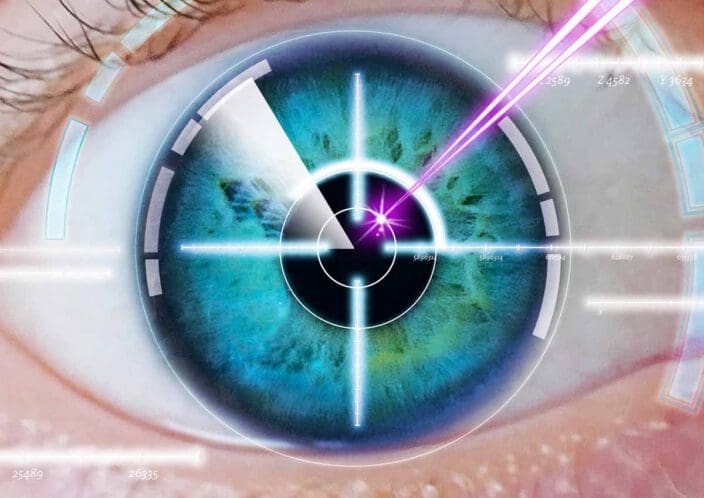How Is Z-LASIK Different From Normal LASIK?
Home / Laser Eye Surgery Guide (Updated) /
Last Updated:
Z-LASIK is a type of advanced LASIK that uses two lasers instead of a blade. It then uses a laser like traditional LASIK does.
This type of LASIK can be used for nearsightedness, astigmatism, and farsightedness. It works by reshaping the cornea.
The corneal flap creation process is what separates Z-LASIK and LASIK. The remainder of the procedure is the same.
There are different considerations for each of the different types of LASIK. Overall, both have very high success rates.
Table of Contents
What Happens During Z-LASIK?

The procedure begins by the patient receiving a relaxing medication. People remain awake during this procedure, but they are relaxed to promote comfort. Eye drops are also applied to numb the area, so the person does not experience pain during this type of LASIK.
During normal LASIK, the doctor uses a microkeratome to create the corneal flap. This flap is created by cutting a portion of the cornea and folding it back so the doctor can easily access the eye structure that they need to reshape.
You deserve clear vision. We can help.
With 135+ locations and over 2.5 million procedures performed, our board-certified eye surgeons deliver results you can trust. Your journey to better vision starts here.
During Z-LASIK, the only difference is that the doctor uses a femtosecond laser to create this corneal flap instead of a microkeratome. The rest of the Z-LASIK procedure is just what someone would experience during a normal LASIK procedure.
The corneal flap looks like a hinge that the doctor folds back, so they have full access to the cornea.
To reshape the cornea, the doctor uses an excimer laser. This highly specialized laser is capable of removing tissue in microscopic amounts. This makes it possible to precisely reshape the cornea. An excimer laser uses cool ultraviolet light to remove the tissue.
Once the surgeon removes enough tissue to reshape the cornea, the procedure is complete. Exactly how the cornea is reshaped depends on the refractive error that is being corrected.
The surgeon has to flatten the cornea when they are working on someone with nearsightedness. They will create a steeper cornea when a person has farsightedness. When someone has astigmatism, the doctor aims to make the shape of the cornea more even. This is generally accomplished by smoothing the cornea’s abnormal shape.

After Surgery
The flap the doctor created is laid back into place after the procedure is complete. There are no bandages or stitches necessary. The cornea heals on its own.
People go home the same day they have Z-LASIK surgery. Following the procedure, they are kept in a recovery space for a short period of time. This allows health care staff to monitor them before they go home.
Once the person is able to be released, they go through a postoperative examination. As long as everything checks out, they are discharged.
It is important that people have a ride home following this surgical procedure. This is because the vision is affected, and the person usually receives a relaxing medicine that can affect reflexes.
Z-LASIK Recovery and Considerations
Recovery is relatively smooth for most people. The risk of severe complications is low.
Though rare, it is possible to experience the following issues after any type of LASIK surgery:
- An overcorrected or undercorrected refractive error
- Inflammation and infection
- The need for additional treatment due to problems with the corneal flap
- Reduced refractive error correction over time
When the corneal flap is made using the Z-LASIK method, there are the following considerations:
- The edema risk is higher than with regular LASIK.
- Compared to regular LASIK, post-surgery vision is typically better.
- Temporary light sensitivity is common.
- Regarding flap thickness, there is no variation.
- Compared to normal LASIK, there is a lower risk of flap complications.
- In most cases, touch-up surgery will not be necessary.
When the corneal flap is made using the normal LASIK method, the following considerations should be noted:
- The complication risk is low.
- If someone experienced errors from a prior LASIK procedure, this is the better option to correct them.
- Compared to Z-LASIK, normal LASIK has a higher risk for “buttonholes.”
- Compared to Z-LASIK, traditional LASIK takes less time to perform.
- Regarding flap thickness, there is a risk for variation.
- Normal LASIK may be more comfortable since less suction is necessary.
- If someone has glaucoma, traditional LASIK is the preferred technique.
You deserve clear vision. We can help.
With 135+ locations and over 2.5 million procedures performed, our board-certified eye surgeons deliver results you can trust. Your journey to better vision starts here.
Comparing the Effectiveness Between Both LASIK Types

A few studies have been conducted comparing LASIK with a blade to the bladeless Z-LASIK type of the procedure. Most indicate that Z-LASIK may have at least a slight advantage over traditional LASIK.
For one study, researchers looked at various clinical results. They ultimately determined that Z-LASIK may be better than standard LASIK. This conclusion is the result of comparing the recovery of people who went through both types.
The group that had the bladeless type fared better during each recovery stage compared to the people who underwent traditional LASIK. Those who had the bladeless type also appeared to get clearer vision faster than the normal LASIK group.
The best technique depends on the individual. However, there is evidence that shows that Z-LASIK may lead to slightly fewer complications and slightly improved visual quality.
Who is A Candidate for Z-Lasik?
Only a comprehensive eye exam can determine if Z-LASIK is safe and appropriate for you. Generally, you’re considered a candidate for the procedure if your ophthalmologist believes you have a high likelihood of success based on several factors, including your overall health, medical history, your dependence on prescription eyewear and the severity of refractive errors that you have.
Your Medical History
Certain health issues can impact the effectiveness of any laser eye surgery. Other conditions may cause side-effects after surgery. Some ophthalmologists won’t perform LASIK on any person with following conditions, based on severity:
- Collagen vascular disease (which affects the connective tissues holding ligaments, muscles, and bones together)
- Autoimmune disease, in which your immune system harms your body instead of protecting it
- Immune-deficient disease, in which your body’s defense against infection and disease is too weak
- Pregnancy
A patient with none of these issues has a better chance of LASIK surgery success.
Dependency on Prescription Eyewear
People with refractive errors are offered LASIK to reduce their dependency on glasses or contact lenses. Thus, this procedure is unnecessary for you if you have near normal vision without correction.
Severity of Refractive Errors
Severe farsightedness, nearsightedness or other refractive errors are generally difficult to correct with LASIK.
Size of Your Cornea
An ultra-thin cornea often does not provide enough tissue for LASIK. Doctors sometimes will approve a patient with a thin cornea, but it’s never a guarantee.
Vision Stability
You’re not a good candidate for LASIK if your vision or glass prescription has changed over the past 12 months. Also, LASIK isn’t appropriate for patients below 18 years old as they’re considered to have unstable vision.
Visual Health
Most ophthalmologists prefer to treat any underlying vision issues before surgery. You may not be an ideal LASIK candidate if you have the following pre-existing eye disorders:
- Glaucoma
- Corneal staining
- Dry eye
- Macular degeneration
- Cataracts
Frequently Asked Questions
Does Z LASIK hurt?
LASIK isn’t usually a painful procedure. The surgeon numbs your eye prior to surgery to prevent discomfort during and immediately after the procedure. If you experience any pain after surgery, you may take painkillers for relief.
Can I drive home after Z LASIK?
It’s not a good idea to drive yourself home following this surgery. You won’t be in great shape to do much for a few hours after you leave the doctor’s office. Consider making prior arrangements to be driven home as soon as possible after LASIK. Doctors recommend resting, or even taking a nap, after you get home from eye surgery.
How long is the Z LASIK recovery time?
Recovery times vary from patient to patient. If there are any complications within six months after LASIK surgery, those will require medical intervention. For most patients, 6 months is long enough for symptoms to go away and vision to improve.
You deserve clear vision. We can help.
With 135+ locations and over 2.5 million procedures performed, our board-certified eye surgeons deliver results you can trust. Your journey to better vision starts here.
References
- LASIK Complication Rate: The Latest Facts and Stats You Should Know. American Refractive Surgery Council.
- What Should I Expect Before, During, and After Surgery? U.S. Food and Drug Administration.
- A Look at LASIK Past, Present, and Future. American Academy of Ophthalmology.
- Blade vs. Laser: Is There a Difference in Outcomes? Review of Ophthalmology.
- How to Determine an Ideal LASIK Candidate. (April 2019). Optometry Times.
- LASIK — Laser Eye Surgery. (October 2020). American Academy of Ophthalmology.
- A Timeline for LASIK Surgery Recovery. (October 2021). All About Vision.
This content is for informational purposes only. It may have been reviewed by a licensed physician, but is not intended to serve as a substitute for professional medical advice. Always consult your healthcare provider with any health concerns. For more, read our Privacy Policy and Editorial Policy.